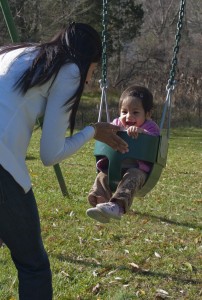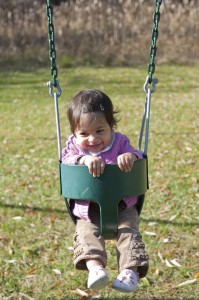When I was young, my mother sent me outside and I would spend HOURS swinging. I would sing, I would close my eyes to surprise myself by how high I’d gone and as I got bigger I’d challenge myself by jumping off at the highest point.
Swinging does so many good things for sensory motor development that listing them all would make an unwieldy run-on sentence. Strength building, improving coordination, organizing the body and mind are just a few features. The full list of benefits are listed below.
The great thing about swinging is that it can be enjoyed at any age. From the infant swing, toddler seat to the old fashioned wood plank roped over a giant tree limb; even most grown-ups will find themselves enjoying the sensation of swinging!
Benefits:
- Helps the body become comfortable to a new kind of movement.
- Helps the eyes to learn how to see the world while moving around.
- Rapid swinging, increases the alertness of the individual.
- Slow swinging relaxes and clams the body.
- When engaging with the caretaker in front of the swing, opportunities for eye contact, language and simple motor planning occur.
- Holding onto the ropes strengthens the hand muscles.
- Keeping upright while swinging strengthens neck and core muscles.
Directions for the swinging experience at each age:
Infants:
1. Swings are generally used to soothe the infant.
2. Talking or singing softly will provide a nice coupling of sounds (auditory input) with motion (swinging back and forth).
3. Placing some tactile type object will provide the opportunity for tactile exploration, thereby activating another sense (the tactile or touch system).
Babies:
1. Once the baby can sit fairly well, a very supportive swing can be used.
2. Speed and force of movement should be carefully calibrated based on how well the child can maintain an upright position and tolerate the swinging motion. If the baby looks fearful, slow it down. If fear remains, take the baby out with cuddles and congratulations for being so brave!
3. Getting used to the swinging motion takes a lot of work. The baby can poop out quickly!
Toddlers:
1. The toddler should be able to sit upright and hold onto the swing fairly well, so increased speed and force can be introduced.
2. Stand in front of the child so you can see the facial expression to determine the child’s comfort level. This also provides the opportunity for eye contact and more engagement.
3. Mix it up: grab the child’s feet for a moment and get the visual attention while saying some diddy such as “Are you ready, are your ready, are you READY TO GO!” That way the child can associate the words with the movement. This becomes a much more active experience for both child and caretaker. The child also feels in more control of the process.
 Notice this toddler looking intently at her Mommy’s hand.
Notice this toddler looking intently at her Mommy’s hand.
Special Considerations:
- Some children are fearful or uncomfortable with the motion of swinging. They may have very sensitive vestibular systems. Introduce swinging by holding the child first and keep the swinging sessions short until the child begins to love the motion.
- Some children do not have the core strength to keep their bodies positioned correctly. For infants, be sure the head is supported adequately. For older babies, if sitting up remains a concern, be sure to add more tummy time activities to the daily schedule.
On More Thought:
Swinging is a fabulous cardio and muscle building exercise. It provides organizing vestibular stimulation. It is a chance to go outside and get some Vitamin D. It burns calories. The electronics are off. Why don’t we all go find a swing right now!




Wow! I love your blog! It is a wonderful thing that you are doing.
Glad you like it!!
Hi Jill, my son is 13 months old and still cannot sit unsupported. Therefore can’t try swinging to improve his visual attention. Any other suggestions for me.
You might try finding a supported seating swing arrangement (try googling it)…meanwhile try lots of tummy time and be sure to place toys in front of him and keep the play dynamic (moving toys around)